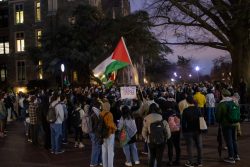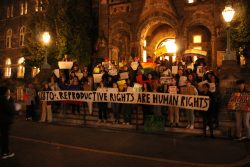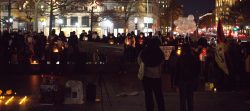About 150 Georgetown students and faculty joined the March for Science in downtown Washington, D.C to advocate for the importance of scientifically informed policy.The Washington march was the main protest of a movement with more than 500 marches on all seven continents.
The group gathered outside of Regents Hall around 10 a.m. Saturday and walked to the Washington Monument where they joined thousands of other protesters. (fernandez-vega.com) They carried signs with slogans including “Kiss me, I’m vaccinated” and “GMO is the way to go.” Some of the marchers wore lab coats and goggles. At the Washington Monument, guest speakers including artist Maya Lin and science educator Bill Nye addressed the crowd. Around 2 p.m., the protesters marched to the Capitol Building.
The march’s organizers have branded it as a non-partisan movement for the advancement of scientifically informed policy. “The application of science to policy is not a partisan issue. Anti-science agendas and policies have been advanced by politicians on both sides of the aisle, and they harm everyone — without exception,” its website reads.
“I teach in the School of Foreign Service so I inherently think health and inequality are fundamentally political questions,” Emily Mendenhall, a professor and medical anthropologist, said. “We can work as much as we want in the lab, but unless real science is implemented at the political level, you’re not going to make real change.” Mendenhall led chants as the students and faculty walked toward the march.
“We inherently see that this isn’t a partisan march,” Heidi Elmendorf, a biology professor and head organizer of Georgetown’s contingent to the march, said. “But obviously the fact that we’re marching to raise public awareness and also political awareness of scientific research means that there are obvious political overtones.”
A small group of students assisted Elmendorf in organizing the protests. The group organized logo submissions, posted flyers around campus, and sold t-shirts in Red Square in the days leading up to the march. That same group of students is in the process of forming Hoyas for Science, a student club that will promote issues of science advocacy on campus.
Julie Bevilacqua (COL ‘19), one of the students involved in the group, said, “the march is making a statement about the fact that science matters and the fact that Georgetown’s willing to take a stand for it, but I think it doesn’t end or it shouldn’t end with the march.” She hopes the club will arrange speakers on campus to address the intersections between science and society.
Science advocacy has become an increasingly important issue in the eyes of many university faculty. “I think one of the things that we’re trying to do more consistently is to offer students opportunities to encounter issues where science and society intersect and encounter them within the curriculum,” Elmendorf said.
For many, the march was an opportunity to address issues of science and society in the real world. “Of course it mattered tremendously to me to have the privilege of marching with a strong Georgetown contingent,” Elmendorf wrote in an email to the Voice after the march. “We represent a university that is uniquely situated to have an impact in the worlds of science and policy – and their profoundly important intersection.”
Image Credits: Isaiah Seibert





